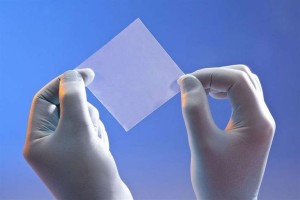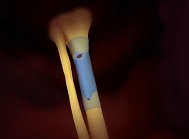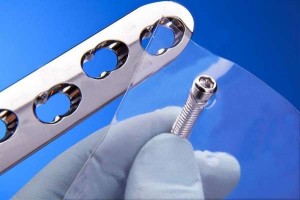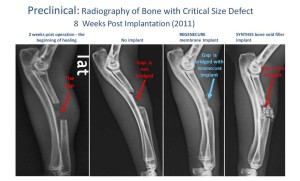 Indeed, wrapping paper! A unique, medical-grade, “intelligent” wrapping paper. Israeli company Regencure has developed a new paper-like technology (regenerative biocompatible polymeric membrane implant) that, when wrapped around broken or injured bones, will enable them to heal faster, smoother, and even compensate for bone loss.
Indeed, wrapping paper! A unique, medical-grade, “intelligent” wrapping paper. Israeli company Regencure has developed a new paper-like technology (regenerative biocompatible polymeric membrane implant) that, when wrapped around broken or injured bones, will enable them to heal faster, smoother, and even compensate for bone loss.
The distinctive technology in this membrane implant is its semi-selective materials made of microporous AMCA (amino methacrylate copolymer type A) and a plasticizer, which allows certain materials to penetrate through the barrier, while keeping others out. For instance, fluids may pass through, but cells and soft tissue, which can infiltrate the healing space and hamper the regenerative process, cannot. This feature greatly enhances the bone’s own natural healing process and decreases the recovery time by up to half.
 How and why exactly does this help? Regencure CEO, Moshe Tzabari, was quoted as saying, “After a fracture there is a competition going on in the human body between soft tissue and bone,” Tzabari explains, “If there is no barrier, soft tissue will infiltrate the wound and stop the bone from growing or make it grow in unintended ways.” The membrane implant operates both as a delivery system for cells and as a device for guided bone regeneration or tissue engineering purposes. It can also be used to deliver active agents such as osteoinductive, antiseptic agents, and more.
How and why exactly does this help? Regencure CEO, Moshe Tzabari, was quoted as saying, “After a fracture there is a competition going on in the human body between soft tissue and bone,” Tzabari explains, “If there is no barrier, soft tissue will infiltrate the wound and stop the bone from growing or make it grow in unintended ways.” The membrane implant operates both as a delivery system for cells and as a device for guided bone regeneration or tissue engineering purposes. It can also be used to deliver active agents such as osteoinductive, antiseptic agents, and more.
 The membrane implant is strong and flexible, but can still be cut, drilled, and shaped into a tube or a patch to span large segmental bone defects. The material was originally developed in Germany, and has been used in the past to coat pills that need to survive stomach acid in order to be digested later in the metabolic process. Michael Friedman, a professor at the Hebrew University, made the discovery that this same material can also be used for guided bone growth for fractures.
The membrane implant is strong and flexible, but can still be cut, drilled, and shaped into a tube or a patch to span large segmental bone defects. The material was originally developed in Germany, and has been used in the past to coat pills that need to survive stomach acid in order to be digested later in the metabolic process. Michael Friedman, a professor at the Hebrew University, made the discovery that this same material can also be used for guided bone growth for fractures.
Preclinical results have shown excellent healing, including complete restoration of bone eight weeks post-osteotomy in a critical size defect model. In fact, comparative research showed that fractures treated only with splints never fully healed, while fractures treated with an additional bone graft took an estimated 28 weeks to heal. However, use of the membrane implant resulted in a more complete healing that also took 28 weeks, and when the use of a bone graft was combined with the membrane implant, complete and thorough healing only took 8-14 weeks. Tzabari stated that, given this information, “The membrane implant can replace bone-graft substitute for better healing or even halve the time of healing if used in combination with bone craft substitute.”

Moreover, this may very well be a look at the future of fracture treatment, for everything from veterinary care for animal fractures, to cranial reconstruction (for which ongoing tests are currently underway), to bone growth for teeth implants of humans. According to Tzabari, the use of membrane implants will not only prove to be less patient for patients, but will be significantly less expensive in the long run. While a second, post-fracture surgery is necessary to harvest bone, costing anywhere between $2,000-$3,000), the membrane implants will only cost an estimated $800. The product is expected to enter the European market sometime near the end of 2015, and upon gaining FDA approval, will enter the U.S. market sometime in 2015.




